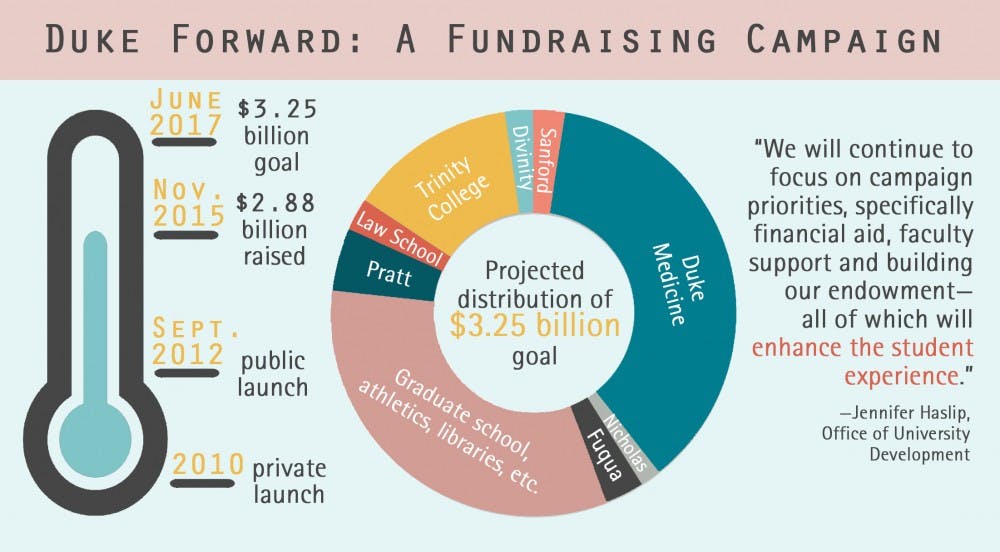Duke Forward is ahead of its fundraising goals, but administrators do not plan to end the campaign early.
As of October, the Duke Forward campaign—which raises funds for Duke’s 10 schools, health system, athletic department, facilities and financial aid—has raised $2.88 billion toward its goal of $3.25 billion by 2017. This puts the campaign ahead of schedule, explained Jennifer Haslip, executive director of development marketing and communications for the Office of University Development. She noted that even if the campaign meets its goal earlier than expected, it will continue until its scheduled end date of June 30, 2017.
“We need to ensure that foundational areas like financial aid and faculty support are adequately funded,” Haslip wrote in an email. “Receiving additional support beyond the campaign’s goal in areas like these sets us up to better serve our students and our faculty in the future.”
Haslip added that raising support for need-based financial aid is a key goal for the campaign moving forward.
“For the next two years, we will continue to focus on campaign priorities, specifically financial aid, faculty support and building our endowment—all of which will enhance the student experience,” she wrote.
Administrators have pointed to limitations in the University’s endowment size as a reason why peer universities have been able to expand their financial aid offerings, either by eliminating loans or lowering the income threshold at which a student’s family is not expected to contribute financially. President Richard Brodhead spoke about these limitations after the October Board of Trustees meeting.
“Universities that have six times as big endowments have added some goodies onto the packages,” Brodhead said.
Data from the U.S. Department of Education’s College Scorecard index compiled by The Chronicle indicates that Brown University, Johns Hopkins University, Vanderbilt University and Rice University are among the schools that have lower average annual net costs for federal financial aid recipients than Duke, despite having smaller endowments than Duke.
Despite the endowment limitations, Haslip noted that all schools, units and initiatives are on track to meet their individual goals as the Duke Forward campaign continues.
Duke is not alone in its fundraising efforts. Several peer universities are also in the middle of ambitious capital campaigns. In September, Harvard reached the $6 billion mark in its $6.5 billion campaign. Johns Hopkins and Georgetown are also making strides on their fundraising goals. Johns Hopkins is continuing toward its goal of $4.5 billion in its campaign, which began in 2010, and Georgetown announced in September that its capital campaign hit its goal of $1.5 billion almost a year ahead of schedule.
The Duke Forward campaign publicly launched in September 2012 after its private launch two years prior. It represents the University’s largest fundraising effort to date and includes every school at Duke along with Duke Athletics and Duke Medicine.
Haslip explained that the campaign has evolved since it started. She noted that some of the funds raised will support new efforts, such as the funding of new library collections and emerging areas of focus like the sciences.
One challenge the campaign has faced is having to educate potential donors about the variety of programs and initiatives supported by the donations, Haslip noted. She added that the Office of University Development is currently looking at ways to broaden Duke’s philanthropic culture.
“We’d like to move beyond the senior gift to establish a culture of philanthropy and giving that begins when students arrive on campus,” she wrote.
Haslip wrote that later this week, the University will release a 2015 campaign impact report, which will contain more detailed updates about the campaign’s progress. She added that the University has not begun formal planning for the next fundraising campaign, which will occur after the completion of Duke Forward.
“We will be reviewing the key objectives and opportunities that the new provost and other academic leadership define through the new strategic plan to ensure that post-campaign fundraising efforts continue to align with the University’s top priorities,” she wrote.

